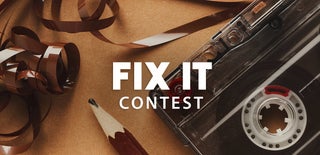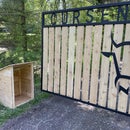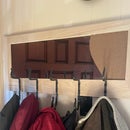Introduction: BBQ Fix
This is how to fix a BBQ instead of throwing it away. This isn't a full BBQ restoration where you take a vintage piece of equipment and make it new. This is the alternative to throwing it away. With that said, we're doing it on the cheap.
The focus on this instructable is on the inside of the grill - the functional parts: how to clean up each component, and what materials to use if you have to replace them.
Supplies
Degreaser: Greased Lightning
The Home Depot Associate thought I was joking when I told him I want a degreaser that should come with gloves and a mask. I want it to double as paint remover. But alas, Home Depot doesn't carry military-grade-anti-aircraft-burn-a-hole-through-your-skin degreaser. Greased Lightning looked potent enough, and it comes in a squirt bottle instead of aerosol spray.
Purple Power
I put this stuff on everything. But it didn't prove as useful here on tough grease. Mostly, it was just used for cleaning up some mildew on the outside of the BBQ.
Thieves Surface Cleaner
An excellent multi-surface cleaner. In this case it was used exclusively for stainless and painted surfaces that don't come in contact with food. Not because it is or isn't food grade - I just needed a bit more oomph for cleaning the inside of the BBQ.
Abrasives: Weber BBQ Scour Pad and Weiland Wire Cup Brush (in drill)
The Weber Scour Pad is course like a Scotchbrite pad, and it comes with a handle and three pads.
The Wire Brush chucks in the drill and saves a lot of elbow grease.
Rivet gun and 1/8" short to medium rivets
Aluminum is standard, but you're better off using steel or stainless steel for this. Aluminum is toxic at high temperatures.
Drill and Bits
The trusty ol' Rigid for drilling holes and running the wire brush.
As long as you wait long enough for all the old spot-welds to completely rust through like I did, you really only need a drill bit for the rivets. One size larger than the rivet - 9/64". or 7/32". Or 3 cm or whatever the metric equivalent is... I don't really know what a cm looks like.
Screws
I used #6 x 1/2" stainless steel screws. Their head is a bit small diameter for the mount hole in some replacement burners, but they can be pre-drilled with the same 3 cm bit as the rivets.
Lots of shop towels, running water
Brand isn't as important as the ability to buy in bulk.
Replacement Parts
This could include new burners, new grates, heat shields, or a slough of other parts.
Burners are available on amazon. Take one off and measure it, or buy some universals. The downside of the universals is having to line up the flame holes. Otherwise, it's a super simple install.
Heat shields are on amazon, too. Those you have to measure. Or maybe just make your own. Online Metals is a great source for small quantity metals, perfect for this project. You can also usually swing by a local sheet metal shop and pick up some scrap for dirt cheap. I highly recommend stainless steel. Take note in the following steps how most items that need replacing are mild steel instead of stainless. The stainless holds up really well to heat and moisture from foods.
Step 1: Replace or Restore?
So there's some serious corrosion on this BBQ. PNW weather has not been kind to it. But it's a nice BBQ, and I like it, so I'm going to bring it back to life.
As you can see, the little metal brackets that hold up the heat shields are almost completely rusted away. They're just spot welded on, so they can be drilled out if necessary.
You can get a pretty extensive replacement kit at Amazon for about $40, and it's all "stainless" steel. Compared to a new $400 BBQ, that sounds like a steal. My BBQ is about as bad as it can get before you should seriously consider buying new. In the next steps, you'll see how bad of shape the metal is in. Most of the back of it rusted through near the spot welds.
It's easy to avoid letting the BBQ get this bad. Mostly, you just need to clean it regularly. Clean out the grease trap, grease tray, and grates regularly. Also, let it heat up before you start grilling, and let it burn for 1/2 hour after you're done grilling (especially if you're grilling with sauces and high-fat foods). The liquids dripping onto the metal parts cause more corrosion than the heat does.
So, assuming you choose to restore instead of replace, it's time to get to cleaning...
Step 2: Cleaning
1. I dumped all the loose metal and big bits into a 5 gallon bucket, then into the trash.
2. Spray liberally with degreaser.
3. Scrub.
Repeat as necessary.
4. Hose it off to remove as much of the chemicals as possible. Later you'll burn off the rest of the degreaser/cleaner residue.
The grease tray in the bottom was the first to go under the sponge. Followed by the burners, the grates, the heat shields, and the rest of the inside of the BBQ.
The Burners. They're probably the easiest and most common thing to replace. Most are manufactured from cheap stainless - like a 400 series metal. It's best if you use a stainless bristled wire brush on these, but you can use a carbon brush if you clean them thoroughly with a citrus-based cleaner. Using citrus is basically a poor-man's passivation to minimize corrosion. The industrial version uses a strong citric acid and is pretty effective.
As you can see in the photos, one of my burners had a big ol' hole in it. Obviously, this will have to be replaced. My Supplies List in step 1 has the link to some good universal burners.
These Heat Shields are ones I made from 304 stainless. 300 series stainless doesn't handle direct heat as well as 400 series so it's not usually used for the burners, but they handle grease and moisture better. These are as old as the rest of the BBQ, and they've held up better than any commercial ones I've seen. 16 ga 304 stainless if you're interested.
Step 3: Prep for Burner and Heat Shield Mounts
The biggest problem I had with this grill before fixing it was the burners and heat shields starting to fall out of their places.
Once I got the old burner mounts off the back of the BBQ, there was some serious corrosion. As you can see in the photos, it was completely rusted through. It all cleaned up pretty well with the wire brush, but it left a big gaping hole.
The rust holes were in an inopportune place, but easy enough to work around by mounting the new pieces upside down so the rivets aren't in the same location as the old spot welds.
Step 4: Burner and Heat Shield Mounts
For the Burner and Heat Shield Mounts, I used 20 ga 304 stainless steel. Onlinemetals.com is a good source for this, or you can get it from a sheet metal shop. Avoid using Aluminum or Galvanized (the most common metals found at local hardware stores), because they both give off toxic fumes when heated.
Drill all the holes while it's flat. No measurement necessary; it can all be eyeballed because you'll have to match drill each one to their new location on the BBQ anyway.
Since most people don't have a finger break, a hammer and vice is adequate. Nobody will notice them under the BBQ grate after reassembly.
The Burner Mounts get three holes each - 2 for mounting, and 1 for a screw that holds the burner in place.
The Heat Shield Mounts get two holes each - for mounting only. Sinking two screws or cutting and bending a tab on either side of the Heat Shield is a good idea, but not one I figured out until later.
Mounting the pieces is pretty simple but tedious - place by hand, drill a hole and rivet it, level, drill second hole, rivet it.
Step 5: Final Cleanup, Burning, and Testing
Cleaning up the outside of the grill is just for aesthetics. Hopefully yours didn't look as bad as mine. But all this mildew and grime is superficial and not baked on, so it goes pretty smoothly with some multi-surface cleaner and shop towels.
Finally it's starting to look usable again.
But... Before you can use a grill that's had chemicals known in the state of California to cause cancer run through it, it's best to burn off any residuals. Crank it to 11 and close the lid. Let it burn for at least an hour; but the longer the better.
Testing is the best part - In my case, local pork chops accompanied by carrots with brown sugar and rendered pig lard.
That metal plate I grill the carrots on? Probably the best BBQ accessory - a 3/8" stainless steel plate. It takes a while to heat up, but grilled potatoes, squash, or carrots are the best on it.

Runner Up in the
Fix It Contest











